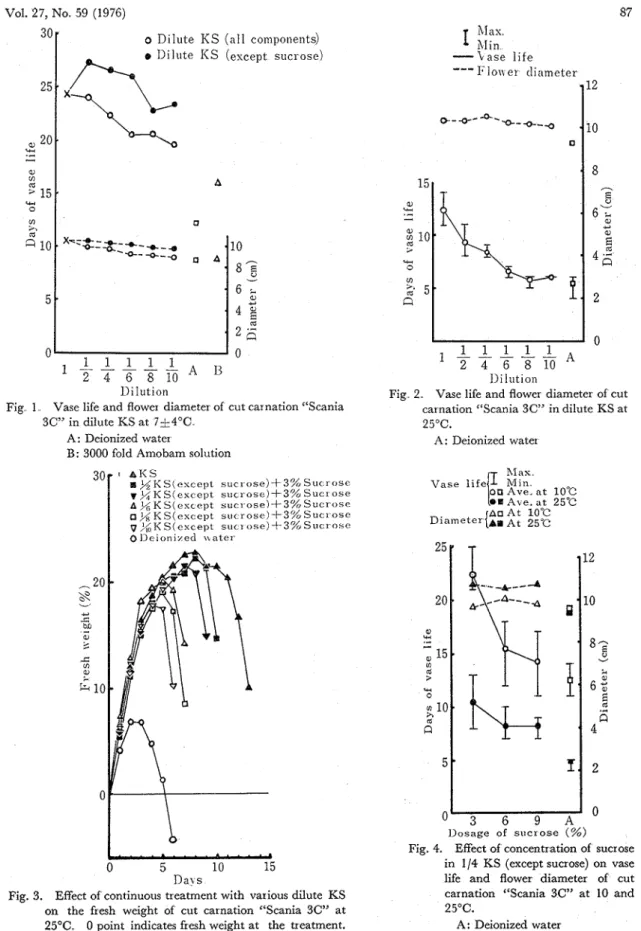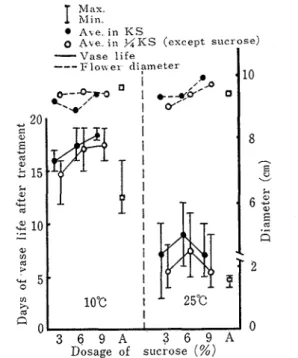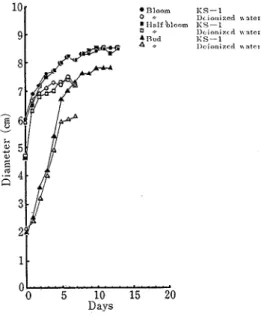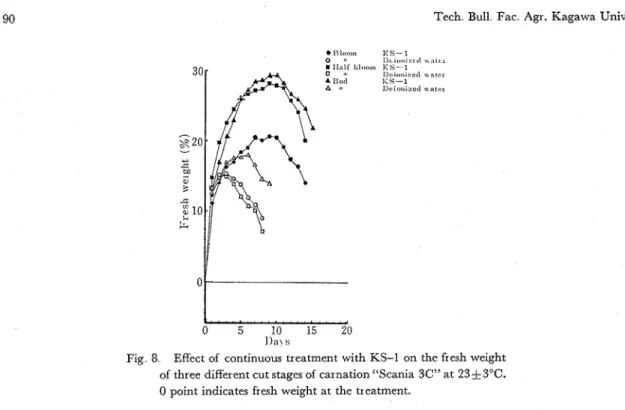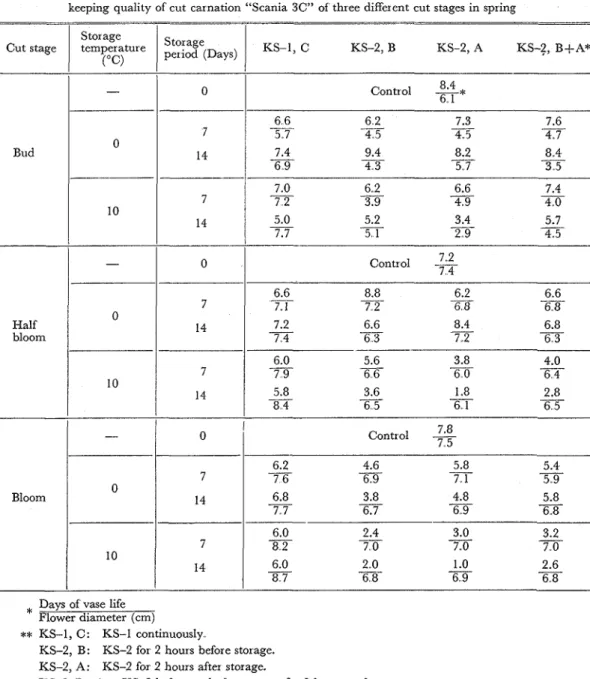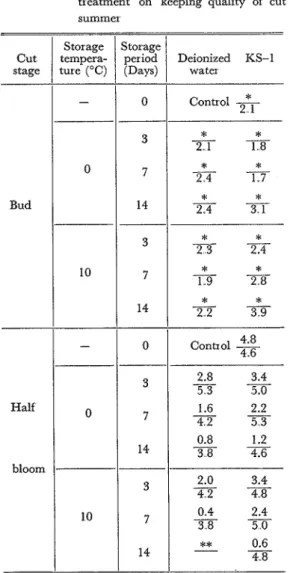STUDIES O N T H E KEEPING QUALITY O F C U T FLOWERS I1 O n the Floral Preservative 'Kagawa Solution' and Its Practical
Use for Cut Carnation
Atsushi HASEGAWA, Mitsuhiro MANABE, Masanori GOI and Yuzuru IHARA
Summary
The present experiments were designed to make clear the effect of KS and modified KS on the keeping quality of cut carnations and the practical use of these floral preservative solutions
1. The continuous use of KS (300 pprn 8-HQ, 500 pprn B-9,20 pprn 6-BA and 3% Sucrose) caused discoloration and collapse of stems, and darkening of red petals. However, KS-I (75 pprn 8-HQ, 125 pprn B-9, 5 pprn 6-BA and 3% Sucrose) could evade these faults without shortening of vase life.
2 Among the solutions tested, KS-2 (300 pprn 8-HQ, 500 pprn B-9, 20 pprn 6-BA and 6% Sucrose) was most effective for the short time treatment
3. When cut carnations in bud were treated with KS-1 continuously, vase life was longer than that of cut carnations in bloom
4 KS-2 treatment for 12 and 24 hours has prolonged the vase life of cut carnations in bloom and half in bloom harvested in spring season, while no effect could be observed in summer sea- son.
5 Combination of low temperature storage with continuous treatment with KS-I was effec- tive to keep the good quality and prolong vase life of cut carnations except in summer
The following combination with KS-1 may be recommended,
(1) Storage within 1 week; cut carnations in bloom and half in bloom a t O°C.
(2) Storage about 2 weeks; cut carnations in bud a t 10°C, cut carnations half in bloom at 0°C
Introduction
Extension of vase life and improvement of post harvest development and maintenance of good quality in cut flowers are highly desirable(ll), and several physical or chemical means are availed to keep good quality of cut flowers For example, low temperature storage(3), controlled atmospheric storage(7) and hypobaric storage(l) are conceivable for physical means, and for chemical means floral preservatives are employed in general. At present, numerous floral preservatives(2~6.8.10) are devised and most of them are composed of bactericidal substances, res- pirable substrates, inhibitors of ethylene production and growth regulating substances.
The floral preservative Kagawa solution(5) (300 pprn 8-HQ, 500 pprn B-9, 20 pprn 6-BA and 3% Sucrose) which was based on the solution devised by Larsen and Scholes(6) and was abbreviated KS in the present study for convenience has some faults as follows. When cut car- nations are treated continuously with KS, they are apt to cause stem discoloration, stem col- lapse and darkening of red flower petals
The present experiments were performed in order to make clear the appropriate concentra- tion of KS for cut carnations and the practical use of it.
Tcch. Bull. Fac Agr Kagawa Univ.
Materials and Methods
Cut carnations of cv. "Scania 3C" were used for winter and spring experiments, and those of CV. "YOSOO~" were used for summer experiments Both cultivars were obtained from com-
mercial carnation grower in Takamatsu City in the morning on the day of treatment Carnations were harvested at about 50 cm length, and leaves on the stem of approximately 10 cm above the base were taken off The cut ends of five cut flowers were placed in aquaous solutions of the floral preservative mixtures (KS and modified KS, Table 1) and deionized water in a Er- lenmeyer's flask or a Wagner pot Quality, diameter and fresh weight of flowers were examined at the appropriate time every day Mean diameter value of flowers was indicated as average of the diameters of 5 flowers, and was shown as average of the widest length and narrowest length of each flower diameter The number of days from the treatment to the first signs of wilting of the petals was referred as the vase life
Results and Discussion
Table 1 KS and modificd KS in thc experiments
-. .- - -. - -
Substance
1
KS KS-I KS-21. Appropriate concentration of KS for continuous use
Continuous treatment of cut carnations with KS usually resulted in the production of the 8-Hydroxyquinoline
N-dimethylamino succinamic acid 6-Benzyladenine Sucrose
largest flowers with the longcst vase life, but it easily caused stem discoloration, collapse of stem tissues to some extents, easy breaking of node, darkening 01 red color in petals, and loss of fresh-
- 300 ppm 75 PPm 300 ppm 500 125 500 20 5 20 3 (%) 3 (%) 6 (%)
-
ness.The first experiment started on January 13, 1974 showed that vase life of cut carnations was shortened by diluting the concentration of KS, but vase life and flower diameter were improved by means of modification in sucrose concentration of diluted KS to 3% (Fig 1).
The second experiment was started on February 17, 1974, and the results are given in Figs 2 and 3 When sucrose concentration was adjusted to 3% in the modified KS, the lower the concentration of other KS components was, the shorter the vase life of cut carnations was The immersed part of stems in undiluted and half diluted KS turned brown Some microorganisms made muddy the 118, 1/10 dilute solutions and deionized water, In these experiments, flowers in the KS and modified KS lots became deep color and the petals were stiffer than those in deionized water control. I t was considered from these results that 114 KS (except sucrose) was the best preservative solution for the continuous use.
Subsequent experiments were made for the determination of the appropriate sucrose con- centration for continuous use of KS The results in Fig 4 indicate that vase life of cut carna- tions in 3% sucrose solutions of rnodificd KS was longer (30-40%) than that in the other solu- tions The flower diameter in every prescrvative solution was larger than that in deionized water, and a t higher temperature it was larger (1 cm) than that a t lower temperature. However, no difference in the flower diameter in the same temperature was shown between the sucrose
Vol. 27, No.. 59 (1976) s u e r o s e ) + 3 % S u c . r o s r s u c r o s e ) + 3 % , S u e r o s e s u e 1 o s e ) + 3 % , % , u c r o s r s u c r o s e ) - k 3 % , S u c l o s c s u c r o s e ) + 3 % S u c r o s c
30- o Dilute I<S ( a l l components)
e Dilute I<S (except s u c ~ o s c )
a, 20.
I
:;e
- L a s e life---
I;lo.i\ er diameter U .--
a, g 1 5 , Y( 0 ?2
1 0 . 5 . IlilutionFig 2 Vase life and flower diameter of cut carnation "Scania 3C" in dilute KS at 25°C.
A: Deionized water
Fig. 3. Effect of continuous treatment with various dilute KS on the fresh weight of cut carnation "Scania 3C" a t
25OC, 0 point indicates fresh weight a t the treatment.
O 1 - - - A 1 1 1 1 1 13 0 2 4 6 8 1 0
Dilution
Fig 1 Vase life and flower diameter of cut carnation "Scania 3C" in dilute KS a t 7&4"C
A: Deionized water
B: 3000 fold Amobam solution A
0
Fig. 4. Effect of concentration of sucrose in 114 KS (except sucrose) on vase life and flower diameter of cut
X';:$:*_+- -.---a
0 - 0-a 0 A
.
#
carnation "Scania 3C" a t 10 and 25°C. A: Deionized water * l o 8 %
-
~ 6 ; . 4 2 2 E88 Tech. Bull.. Fac. Agr. Kagawa Univ., concentrations I t is likely that sucrose concentration much affected vase life, but little affected flower diameter and flower color Preservative solution modified to 114 KS (except sucrose) was most effective for the continuous use; hence this solution is abbreviated KS-1.
2. Appropriate concentration of the floral preservative K S for the short time treatment Basal stems of cut carnations in bloom of "Scania 3C" were immersed in six test solutions (3, 6, 9% sucrose in both KS and KS-1) and deionized water a t 10°C and 25°C for 2 hours, and then rinsed out and immersed again in deionized water of Wagner pots a t 10°C and 25°C temperature, respectively
Vase life a t 10°C was approximately three times longer than that at 25OC, and undilute KS was more effective than KS-1 a t both temperatures (Fig. 5) Flower diameter and flower color were little affected by temperature and sucrose concentration I n the case of the short time treatment, it is clear that 6 and 9% sucrose in K S effectively affected vase life, but 9% sucrose in K S shortened vase life a t high temperature.
Modified K S containing 6% sucrose is most effective for the short time treatment; hence this solution is abbreviated KS-2.
Fig. 5 . Effect of concentration of KS and sucrose on
vase life and flower diameter of cut carnation "Scania 3C" in short time (2 hours) treatment a t
10°C and 25OC,
A: Deionized water
3. Effect of continuous treatment with KS-1 on the keeping quality of different cut stage car- nations
Cut carnations in three stages of bloom were used, those were in bloom (6cm diameter), half in bloom (4.5 cm), and in bud (2.0 cm). They were harvested on May 12, 1974 and were put in KS-1 and deionized water a t 23f 3°C. I n KS-1 and deionized water, vase life of cut car-
Vol.. 27, No. 59 (1976) 89
nations of cut stage in bud was longer than that of other cut stages (Fig. 6). Number of days in commercial value in KS-1, commercial value means over 6 cm flower diameter in bloom, was 13.8 days for cut stage in bloom, 12 6 days for half in bloom, 11.0 days for in bud, respectively. I n deionized water, it was 7 8 days for cut stage in bloom, 6 2 days for half in bloom, 2.4 days for in bud, respectively Flower diameter of all flowers in KS-I lot was larger than that in deio- nized water, and the increasing tendency of flower diameter was remarkable for cut stage in bud (Fig. 7)" The same trend as in flower diameter was shown (Fig 8) I n this experiment, cut carnations in bud came into in bloom even in deionized water, but the term after 6 cm in flower diameter was only a few days. Cut carnations in bud in KS-1 had the longest vase life and the term after 6 cm of flower diameter was 3 days longer than that in bloom in deionized water control, and they came into full bloom. Though it is a customary practice to harvest only in bloom for growers, these results indicate the feasibility of the extension of harvest time of cut carnations.
4. Effect of the short time treatment with KS-2 on the keeping quality of different cut stage carnations
The first experiment was started on May 26, 1974, with "Scania 3C". The flower diameter of each cut stage was 6 3 cm in bloom, 2.8 cm half in bloom, 2.0 cm in bud, respectively. After the treatment with KS-2 for several hours, these cut carnations were placed in deionized water a t 2 3 6 3°C.
The second experiment was started on August 16, 1974, with "Yosooi". The flower diameter of each cut stage was 5 2 cm in bloom, 2.1 cm half in bloom, 1.4 cm in bud, respectively. After the treatment with KS-2 for several hours, they were placed in deionized water a t 30f 1.5OC. Vase life and flower diameter are given in Table 2.
I n regard to vase life, there were some differences between the experiments. I n the spring experiments, vase life of each cut stage became longer in proportion to the time in 24 hours I n
1 Min b A c e i n ICS-1 0 A v e a f t e r bloom &, ; e in deionized \z ate1 T 0 A v e a f t e r bloom Rloom 0 r llnlf bloom D I , A litlcl A 0 0 ;
Bud Half bloom Bloom Cut stages of carnation a t treatment
'
0 5 10 15 20
Days
Fig 6. Effect of continuous treatment with Fig 7. Effect of continuous treatment with KS-I on KS-1 on vase life of three different cut flower diameter of three different cut stages of stages of carnation "Scania 3C" a t 23f 3°C. carnation "Scania 3C" at 23f 3OC.
Tech. Bull Fac. Agr. Kagawa Univ. I<S-1 I>'lonilrcl I < S - 1 Ilcioni~ed liS-1 Deionized 0 5 10 15 20 ])a\ s
Fig 8 Effect of continuous treatment with KS-1 on the fresh weight of three different cut stages of carnation "Scania 3C" at 23f 3OC. 0 point indicates fresh weight at the treatment.
the summer experiments, there was little effect of the treatment on vase life.
These results suggest that the short time treatment of KS-2 is useful for cut carnations half in bloom and in bloom a t any season other than summer.
Table 2 Effect of hours under treatment with KS-2 on vase life and flower diameter of cut carnation "Scania 3C" and "Yosooi" at room temperature
- - -- - -- -
-Cv Cut Hours under treatment
Date 1 2 4 12 24 48 96 Scania 3C 26 May Bud Half bloom Bloom Yosooi 16 August Bud Half bloom Bloom Days of vase life Flower diameter (cm)
*
Could not bloom.Flower diameter is indicated on the 7th day after treatment.
5. Effect of the combination of low temperature storage with the floral preservative solutions on the keeping quality of cut carnations in the three different cut stages
The first experiment was started on May 12, 1974, with "Scania 3C". The flower diameter of each cut stage was 6.3 cm in bloom, 4.1 cm half in bloom, 2.1 cm in bud, respectively. Stor-
Vol. 2 7, No. 59 (1976) 91
age temperatures were O°C and 10°C, storage periods were 7 days and 14 days, and floral pre- servative solutions were as follows, (1) KS-1 during the storage periods, (2) KS-2 for 2 hours before the storage, (3) KS-2 for 2 hours after the storage and (4) ICS-2 for 2 hours both before and after the storage Cut carnations treated with KS-2 before the storage were brought into some polyethylene film bags (0.1 mm in thickness) to prevent from drying during storage. After the storage, cut carnations of all lots were placed in deionized water at 23&3OC.
As shown in Table 3, vase life of cut carnations ranged between 7.4 days and 5.0 days in the lots of KS-1. There are great dispersion and no definite tendency in the Iots of the other
Table 3 Effect of the combination of low temperature storage with KS-1 and KS--2 treatment on keeping quality of cut carnation "Scania 3C" of three different cut stages in spring
Storage
c u t stage
1
t e m ~ e t u r e1
1
KS-I,c
KS-2, B KS-2, A KS-?, B+A**I - 1 ° 1
Control-*
8.4 6 1I - 1 ° 1
Control - 7.2 7.4 Bud U 6.6-
-
8.4 6.8 7 2-
bloom 6 3 6 3 I1 - 1
O 1 7.8 Control-
7.5 0 10 U Bloom-
3.8-
4.8-
5.8 6.7 6.9 6..8*
Days of vase life Flower diameter (cm)**
KS-1, C: KS-1 continuouslyKS-2, B: KS-2 for 2 hours before storage. KS-2, A: KS-2 for 2 hours after storage.
KS-2, B+A: KS-2 before and after storage for 2 hours each
7 14
-
7 14 6 6-
-
6 2 - 7.3-
7.6 5 7 4 5 4 5 4.7 7.4 9.4 8.2-
--
8 4 6 9 4 3 5 7-
3 5 7.0 6 2 --
-
6.6 - 7.4 7 2 3.9 4 9 4 0 - 5.0-
5.2-
3.4 - 5.7 7.7 5 1 2 9 4 592 Tech. Bull.. Fac.. Agr.. Kagawa Univ.. preservative solution. In the lots of KS-1 treatment during the storage, cut carnations of 14 days storage a t 0°C had longer vase life than that of 7 days, but cut carnations of 7 days storage at 10°C had longer vase life than that of 14 days, Cut carnations in bud stage were failed to bloom in the KS-2 plot. There was a clear relationship between storage temperature and flower diameter in all cut stages. The cut carnations of 10°C storage had greater flower diameter than those of 0°C. There were no changes of flower color among all lots in KS-1, but most flowers in KS-2 were turned dark red and many flower petals were incurved.
The second experiment was started on August 10, 1974, treating "Yosooi" with KS-1 or de- ionized water The flower diameter of each cut stage was 3-8 cm in bloom, 1.7 cm half in bloom, 1.4cm in bud, respectively. In this experiment, storage temperatures were 0°C and 10°C, and storage periods were 3 days, 7 days and 14 days. After the storage, cut carnations were kept in deionized water at 29.7&Z°C. All cut carnations in bud were failed to bloom regardless the treatments (Table 4). Vase life of cut carnations treated in bloom and half in bloom was shorter than that of control. Flower diameter of cut carnations in bloom and half in bloom in KS-1 was
Table 4 Effect of combination of low temperature storage with KS-1 or deionized water treatment on keeping quality of cut carnation "Yosooi" of three different cut stages in summer
Days of vase life Flower diameter (cm) Control .* 2.1
*
*
- -
2.1 1 ..8*
*
-
-
2.4 1.7*
*
.- 2.4 -. 3.1*
*
-
-
2.3 2.4*
*
.--
1 ..9 2.8*
*
-
-
2.2 3.9 4.8 Control-
4..6 3.4 2.8-
- 5.3 .5.0 1.6 2.2 - - 4.2 5,.3 0.8-
- 1.2 3.8 4.6 3.4 2.0-
-
4.2 4..8 0.4 2.4 --
3..8 5 .O**
0.6 - - 4..8 Bud Half bloom BloomFlower diameter is indicated on the 7th day after storage.
*
Could not bloom.**
Wilted during storage.***
Wilted.-
0 10 - 0 10 0 0 3 7 14 3 7 14 0 3 7 14 3 7 14 7 14 3.2 1.0-
--
.5.6 .5.6 0.6-
- 2.4 5..2 5.8slightly greater than that in deionized water. Flower color of" some petals was dappled and the dapples were remarkable in 14 days storage a t O°C
As mentioned above, KS-1 treatment during storage has made possible to prolong vase life of cut carnations in spring season. But it was better when cut carnations in bud were stored a t 10°C, and also in the case of cut carnations in bloom and half in bloom, it may be recommended to store a t O°C for the reason that the flowers stored a t 10°C become in bloom too early. I n summer season, it was impossible to prolong vase life of cut carnations by means of any treatment during storage.
Many flor a1 preservative solutions have been devised When these flor a1 preservative solu- tions are used a t high concentrations, however, sometimes they may cause discoloration and col- lapse of stems(4). The Kagawa solution also has similar faults When KS is used continuously for cut carnations, these faults were evaded by means of the dilution of KS concentration (except sucrose) to 1 14.
I n the present experiments, cut carnations in bud in spring season could come into bloom by means of the continuous treatment with KS-1 and the short time (12-24 hours) treatment with KS-2, but in summer season cut carnations in bud could not bloom by the same treatments with KS-2 Moreover in the summer experiments, in which the effect of combination of low tempera- ture storage with the floral preservative solution was examined, cut carnations in bud could not bloom by means of any treatment. And also, in spring cut carnations in bud could be stored during 1 to 2 weeks a t 10°C and during 2 weeks or more at O°C without shortening of vase life and loss of quality. These differences of the results between the experiments in spring and in summer may be due to the seasonal differences of environmental conditions and quality of test materials. Further studies are necessary for preservative characters of the cultivars used in the experiments
I n general, cut carnations have been customarily harvested in bloom, but cut carnations half in bloom and in bud are able to bloom by effective use of floral preservative solutions(2,4). Parups(9) reported that the extension of vase life in the cut rose cv "Forever Yours" was the long- est when the preservative was used during the consumer period, and this extension in vase life was less when used during the simulated wholesale and retail marketing periods. O u r results suggest that combination of cut stage of flower with storage by preservative solutions may extend the harvest time for growers, and the use of floral preservative solutions during the consumer periods gives warranty of good quality of cut flowers at least for several days.
Acknowledgment
The authors are much indebted to Dr. Hirotoshi KITAGAWA, Associate Professor a t Kagawa University for his very helpful advice and help.
Thanks are given to Mr Kazuo OGURA for his kindness and help.
Cut carnations used in these experiments were kindly supplied by Mr Yukio MANABE, com- mercial carnation grower in Takamatsu City.
Literature Cited
( 1 ) BURG, S P,: Hypobaric storage of cut flowers, thiadiazole extends cut carnation flower life, HortScience, 8, 202-205 (1973) HortSczence, 8, 334-335 (1973).
Tech. Bull. Fac. Agr.. Kagawa Univ. flower, Pro Amer. Soc Hort Scz , 61, 585-592
(1953).
( 4 ) HARDENDURG, R E
,
VAUGHT, H C., BROWN, G A : Development and vase life of bud-cut Colorado and California carnations in preserva- tive solution following air shipment to Mary- land, J. Amer Soc Hort Scz 95, 18-22 (1970). ( 5 ) HASEGAWA, A , UEHARA, T , GOI, M : Studies on the keeping quality of cut flowers, I. Effect of growth regulating substances on the longevity of cut carnation and cut chrysanthemum, Tech. Bull Fac Agr Kagawa Unzv, 25, 43-52 (1973), (in Japanese).( 6 ) LARSEN, F. E., SCHOLES, J F. : Effects of SU-
crose, 8-hydroxyquinoline citrate, and N- dimethyl amino succinamic acid on vase-life and quality of cut carnation, Pro Amer. Soc Hort Scz , 87, 458-463 (1965)
( 7 ) PARSONS, C S , ASEN, S
,
STUART, N W :Controlled atmosphere storage of daffodil flowers, Pro Amer Soc Hort. Scz , 90, 506-5 14 (1967)
( 8 ) PARUPS, E V , CHAN, A P : Extension of vase-life of cut flowers by use of Isoascorbate- containing preservative solution, J Amer Soc Hort Sci ,98, 22-26 (1973)
( 9 ) PARUPS, E V.: Effects of Flower Care floral preservative on the vase-life and bloom size of Rosa hybrida cv "Forever Yours" roses, Can
J Plant Scz ,55, 775-781 (1975)
(10) PARUPS, E V : Inhibition of ethylene synthesis by Benzylisothiocyanate and its use to delay the senescence of carnations, HortSczence, 10, 221- 222 (1975)
(1 1) ROGERS, M N : An historical and critical re- view of postharvest physiology research on cut flowers, HortSczence, 8, 189-1 94 (1 973).
r n E @ l 8 B & % i C M $ 6 R %
II
WE#gg
'Kagawa solution' @l@Jz%)-
+
-. y 7 iC$j$6
gjadl&i~~t,>*r
E4$Jll~~,
B%%%,
5.#PXB,
EE
?%
$;Bi$&i2WlE0 E %
t
l;iJk ~c#J%B hWJE%8?& Kagawa solution (U.7; KS t@E)
K 7 br ,
WlEk-
$ , - V a ~ Q $ i t H " i t L R . I I : t ~ ~ ~ T & 8 L , U T O d : 5 %%SB%%#R.1 300ppm 8-HQ, 5OOppm B-9,20ppm 6-BA, 3%Sucrose $.
t>
h Q KS (I= k-
2%-
2 a 2 Q S U L -C#+ 2 , 8OBB%$i4&$%2 L, Z l @ j S i B S
<
h 3 %$> b i 5 f i - W<
h Q. -% 7':%&%TddE~$~@%f3k:h Q h t OE%:-Q4 C .tr $, Sucrose % O &3 0 91
(75ppm 8-HQ, 125ppm B-9,5ppm 6-BA) t L, Sucrose 9 3 % t:L
7': KS4
-1 Q H b Q t t K d ; 3 , E % 9 8 Y Q t t h < E % Q % t f Q t t $ ~ T d t : .
2 gBi@f'd%%S @ Q %&it, KS 0 Sucrose EEO8 9 6 %I= LIE KS-2 (300ppm 8-HQ, 500ppm B-9, 20ppm 6-BA, G%Sucrose) i5i@ % # J R ~ T & 9 7':.
3 7134TREL7':k-;i.-Pay%KS-lt=%%LT#$td:<HEL, A E @ 9 E F 3 % B K ~ B b % E L 7 ' : % D L 3 % f < h7f:.
4. KS-2 912-24@Pd%%s*b t t 3 , 7 1 3 8 , +H, H E % E T % E L I : b Y f i 8 w I Z O E % % f
<
h 7?:di, BFOfB&Ct7134, +HOWlE1.ECtB%$ih;6~77':.5. %%O@iEMU.%it, &%%I+ KS-1 Q@%S*Q t t K L 3 , BFZ@OWlEOa"aB, EI%:-QHE%ET% EL7':WlGt Hj&Et:%7 t tdiT37': ?G~%&~~U.TO#£~&@~~~%SB!XJT& 77':.
( 1 1 B?dADfl"rB ; H E & & U;*H%E, 0°C. ( 2 $3 2 iNrd~fl"rL% ; 7 C 3 8 % E , 10°C, + H % E , 0°C

